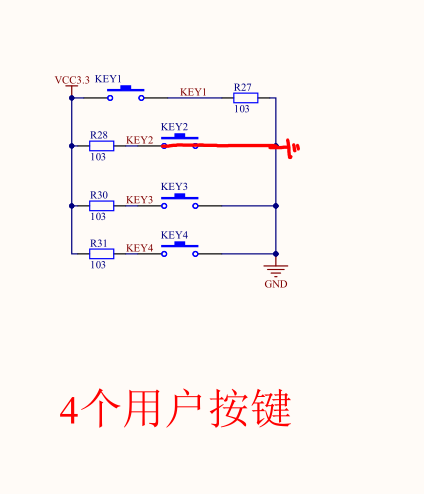2021/10/12智能家具嵌入式实训第三天 蜂鸣器+按键代码 (1)
完成昨天的蜂鸣器+按键+led代码
led:
原理图:




代码部分:
先定义led.h
1 1 #ifndef __LED_H 2 2 #define __LED_H 3 3 4 4 #include "stm32f10x.h" 5 5 #include "delay.h" 6 6 7 7 /* 管脚宏定义*/ 8 8 #define LED1_PORT GPIOE 9 9 #define LED1_PIN 2 10 10 #define LED2_PORT GPIOE 11 11 #define LED2_PIN 3 12 12 #define LED3_PORT GPIOE 13 13 #define LED3_PIN 4 14 14 #define LED4_PORT GPIOE 15 15 #define LED4_PIN 5 16 /* 操作宏定义 */ 17 enum LED_CONDITION{OFF,ON}; 18 #define LED1(x) (x)?GPIO_ResetBits(LED1_PORT,GPIO_Pin_2):GPIO_SetBits(LED1_PORT,GPIO_Pin_2) // 1 -- 打开 0 -- 关闭 19 #define LED2(x) (x)?GPIO_ResetBits(LED2_PORT,GPIO_Pin_3):GPIO_SetBits(LED2_PORT,GPIO_Pin_3) 20 #define LED3(x) (x)?GPIO_ResetBits(LED3_PORT,GPIO_Pin_4):GPIO_SetBits(LED3_PORT,GPIO_Pin_4) 21 #define LED4(x) (x)?GPIO_ResetBits(LED4_PORT,GPIO_Pin_5):GPIO_SetBits(LED4_PORT,GPIO_Pin_5)
enum:枚举 https://www.runoob.com/cprogramming/c-enum.html
#define LED1(x) (x)?GPIO_ResetBits(LED1_PORT,GPIO_Pin_2):GPIO_SetBits(LED1_PORT,GPIO_Pin_2) // 1 -- 打开 0 -- 关闭
#define又称宏定义,标识符为所定义的宏名,简称宏。
定义变量 LED1
就是x是1执行第一种情况,是0执行第二种情况
x=1是假,A为假,则C
GPIO_SetBits(LED1_PORT,GPIO_Pin_2 打开
x=1是真,A为真,则B
GPIO_ResetBits(LED1_PORT,GPIO_Pin_2) 关闭

这里老师讲的设置led翻转
寄存器ODR就是控制对应引脚的高低电平,每组16位,与寄存器ODR的低16位一致,故若想让LED灯刚开始是灭的,需要输出高电平,那么就将对应的位置1即可,
#define LED1_TOGGLE (LED1_PORT->ODR ^= (1 << LED1_PIN)) #define LED2_TOGGLE (LED2_PORT->ODR ^= (1 << LED2_PIN)) #define LED3_TOGGLE (LED3_PORT->ODR ^= (1 << LED3_PIN)) #define LED4_TOGGLE (LED4_PORT->ODR ^= (1 << LED4_PIN))
^=是C/C++的一个符合运算符。表示异或赋值。
如:
a^=b相当于:a=a^b;
举例:(LED1_PORT->ODR ^= (1 << LED1_PIN))
LED1_PORT->ODR^=1 << LED1_PIN
1<<2= 0000 0001 变为 0000 0100
如果原本是亮的,0000 0100
0000 0100^=0000 0100=00000000
变为0,不亮
在定义函数
/* 函数*/ void LED_Config(int condition); void LED_Breath(void); void LED_Twinkle(void);
#endif
整体代码:led.h

1 #ifndef __LED_H 2 #define __LED_H 3 4 #include "stm32f10x.h" 5 #include "delay.h" 6 7 /* 管脚宏定义 */ 8 #define LED1_PORT GPIOE 9 #define LED1_PIN 2 10 #define LED2_PORT GPIOE 11 #define LED2_PIN 3 12 #define LED3_PORT GPIOE 13 #define LED3_PIN 4 14 #define LED4_PORT GPIOE 15 #define LED4_PIN 5 16 17 /* 操作宏定义*/ 18 enum LED_CONDITION{OFF,ON}; 19 #define LED1(x) (x)?GPIO_ResetBits(LED1_PORT,GPIO_Pin_2):GPIO_SetBits(LED1_PORT,GPIO_Pin_2) // 1 -- ´ò¿ª £¬ 0 -- ¹Ø±Õ 20 #define LED2(x) (x)?GPIO_ResetBits(LED2_PORT,GPIO_Pin_3):GPIO_SetBits(LED2_PORT,GPIO_Pin_3) 21 #define LED3(x) (x)?GPIO_ResetBits(LED3_PORT,GPIO_Pin_4):GPIO_SetBits(LED3_PORT,GPIO_Pin_4) 22 #define LED4(x) (x)?GPIO_ResetBits(LED4_PORT,GPIO_Pin_5):GPIO_SetBits(LED4_PORT,GPIO_Pin_5) 23 24 #define LED1_TOGGLE (LED1_PORT->ODR ^= (1 << LED1_PIN)) 25 #define LED2_TOGGLE (LED2_PORT->ODR ^= (1 << LED2_PIN)) 26 #define LED3_TOGGLE (LED3_PORT->ODR ^= (1 << LED3_PIN)) 27 #define LED4_TOGGLE (LED4_PORT->ODR ^= (1 << LED4_PIN)) 28 29 /* 函数定义 */ 30 void LED_Config(int condition); 31 void LED_Breath(void); 32 void LED_Twinkle(void); 33 34 #endif
再led.c主代码
#include "led.h" /*********************************************************************************** 函数功能: LED初始化 形参:condition -- 初始状态(ON、OFF) 返回值:无 ***********************************************************************************/ /* 管脚: LED1 PE2 LED2 PE3 LED3 PE4 LED4 PE5 */
首先LED_Config 函数
开关灯
这里老师用了二种方法
void LED_Config(int condition) {
1.寄存器法
#if 1 /* 寄存器法 */ // 1.时钟使能 -- GPIOE端口时钟 RCC->APB2ENR |= (0x1<<6); // 2.模式配置(通用推挽输出) GPIOE->CRL &= ~(0xFFFF<<8); //清零 -- [23:8]位 GPIOE->CRL |= (0x3333<<8); //置位 // 3.初始状态 if(condition == OFF) GPIOE->ODR |= (0xF<<2); else GPIOE->ODR &= ~(0xF<<2);
配置 RCC->APB2ENR 寄存器 使能时钟端口
打开STM32中文参考手册,先找到第七章中关于RCC寄存器(APB2外设使能寄存器),找到可以发现以下:
根据电路图可知,我们需要对IO端口E的时钟进行使能,有根据手册可知是第6位置置置为1表示开启。

#if 1
/* 寄存器法 */
// 1.时钟使能 -- GPIOE端口时钟
RCC->APB2ENR |= (0x1<<6);
1移动6位 使第六位变为1 开启 使能
// 2.模式配置(通用推挽输出)
GPIOE->CRL &= ~(0xFFFF<<8); //清零 -- [23:8]位
GPIOE->CRL |= (0x3333<<8); //置位
0xFFFF 左移动8位 1111 1111 1111 1111 变为 1111 1111 0000 0000 0xFF00
GPIOE->CRL =GPIOE->CRL & 0000 0000 1111 1111
后面的都变为0
0x3333左移动 8位置 0100 0100 0100 0100 变为 0x3300
然后初始化状态
// 3.初始状态
if(condition == OFF)
GPIOE->ODR |= (0xF<<2);
else
GPIOE->ODR &= ~(0xF<<2);
如果关闭 0xF <<2 = 1111 变为 1111 00
GPIOE->ODR 同或 相等为1
所以如果关闭 2位置上 与1同或
0与1为0 关闭
如果开启
与1111 00 位与
2位置上 1&1 1 开启
a &= b就是 a= a & b
0xF是二进制的1111,左移1位就是在右边加个0,也就是11110,左移8位就在右边加8个0,也就是1111 0000 0000
char类型的话只有8位,就是后面8个0,前面的4个1移出去了。
2.库函数法
//1.时钟使能 RCC_APB2PeriphClockCmd(RCC_APB2Periph_GPIOE,ENABLE); //2.模式配置 GPIO_InitTypeDef GPIO_InitStructure; GPIO_InitStructure.GPIO_Mode = GPIO_Mode_Out_PP; GPIO_InitStructure.GPIO_Speed = GPIO_Speed_50MHz; GPIO_InitStructure.GPIO_Pin = GPIO_Pin_2 | GPIO_Pin_3 | GPIO_Pin_4 | GPIO_Pin_5; GPIO_Init(GPIOE, &GPIO_InitStructure); //3.初始状态 if(condition == OFF){ GPIO_SetBits(GPIOE,GPIO_Pin_2 | GPIO_Pin_3 | GPIO_Pin_4 | GPIO_Pin_5); } else{ GPIO_ResetBits(GPIOE,GPIO_Pin_2 | GPIO_Pin_3 | GPIO_Pin_4 | GPIO_Pin_5); } #endif
正常定义
这里利用了RCC_APB2PeriphClockCmd函数
最后写函数功能
/*********************************************************************************** 函数功能: LED 函数接口 ***********************************************************************************/ /* * 呼吸灯(模拟PWM波) */ void LED_Breath(void) { int i = 0; for(i=0;i<1000;i++) //逐渐变亮 { LED1(ON);LED2(ON);LED3(ON);LED4(ON); Delay_nop_nus(i); LED1(OFF);LED2(OFF);LED3(OFF);LED4(OFF); Delay_nop_nus(1000-i); } for(i=0;i<1000;i++) //逐渐变暗 { LED1(OFF);LED2(OFF);LED3(OFF);LED4(OFF); Delay_nop_nus(i); LED1(ON);LED2(ON);LED3(ON);LED4(ON); Delay_nop_nus(1000-i); } } /* * LED闪烁 */ void LED_Twinkle(void) { Delay_nop_nms(500); LED1_TOGGLE;LED2_TOGGLE;LED3_TOGGLE;LED4_TOGGLE; }
结束
编写主函数 main
main.h
#ifndef __MAIN_H #define __MAIN_H #include "stm32f10x.h" #include "delay.h" #include "led.h" #endif
mian.c
#include "main.h" int main(void) {
LED_Config(ON); while(1) { LED_Breath(); //呼吸灯 LED_Twinkle(); //闪烁灯 } }
然后照这个格式写蜂鸣器和按键
蜂鸣器 BEEP:
beep.h
#ifndef _BEEP_H_ #define _BEEP_H_ #include "stm32f10x.h" #include "led.h" #define BEEP(x) (x)?GPIO_SetBits(GPIOC,GPIO_Pin_0):GPIO_ResetBits(GPIOC,GPIO_Pin_0) // 1 -- 打开 , 0 -- 关闭 #define BEEP_TOGGLE (GPIOC->ODR ^= (0x1<<0)) void Beep_Config(uint8_t condition); void Beep_Twinkle(void); #endif
#define BEEP_TOGGLE (GPIOC->ODR ^= (0x1<<0))
也是蜂鸣器翻转
BEEP_TOGGLE =GPIOC->ODR异或1
取反
这个蜂鸣器端口正好是pc0
所以0位置 <<0


GPIOC->ODR ^= (0x1<<0) 即为
GPIOC->ODR= GPIOC->ODR 异或 1
如果为开启的时候
GPIOC->ODR为 1 响 高电平
响的时候 1异或1 为0
关闭
condition借用了
led.h
enum LED_CONDITION{OFF,ON};
beep.c
寄存器法
#include "beep.h" /*********************************************************************************** 函数功能: BEEP初始化 形参:condition -- 初始状态(ON、OFF) 返回值:无 ***********************************************************************************/ /* 管脚: BEEP -- PC0(通用推挽输出) */ void Beep_Config(uint8_t condition) { //1.时钟使能 RCC_APB2PeriphClockCmd(RCC_APB2Periph_GPIOC,ENABLE); //2.配置模式 GPIO_InitTypeDef GPIO_InitStruct; GPIO_InitStruct.GPIO_Mode = GPIO_Mode_Out_PP; GPIO_InitStruct.GPIO_Speed = GPIO_Speed_50MHz; GPIO_InitStruct.GPIO_Pin = GPIO_Pin_0; GPIO_Init(GPIOC,&GPIO_InitStruct); //3.初始化 if(condition == OFF) GPIO_ResetBits(GPIOC,GPIO_Pin_0); else GPIO_SetBits(GPIOC,GPIO_Pin_0); }
/*********************************************************************************** 函数功能: BEEP函数接口 ***********************************************************************************/ /* * BEEP蜂鸣器间断响 */ void Beep_Twinkle(void) { Delay_nop_nms(1000); BEEP_TOGGLE; }
最后main.c
记得main.h加进去 beep.h
#ifndef __MAIN_H #define __MAIN_H #include "stm32f10x.h" #include "delay.h" #include "led.h" #include "beep.h" #endif
#include "main.h" int main(void) { LED_Config(ON); Beep_Config(OFF); //刚开始关闭 while(1) { //LED_Breath(); //呼吸灯 //LED_Twinkle(); //闪烁灯 Beep_Twinkle();//蜂鸣器间断响 } }
最后按键代码 key:



先写key.h
#ifndef _KEY_H_ #define _KEY_H_ #include "stm32f10x.h" #include "delay.h" #define KEY1 GPIO_ReadInputDataBit(GPIOA,GPIO_Pin_0) #define KEY2 GPIO_ReadInputDataBit(GPIOC,GPIO_Pin_4) #define KEY3 GPIO_ReadInputDataBit(GPIOC,GPIO_Pin_5) #define KEY4 GPIO_ReadInputDataBit(GPIOC,GPIO_Pin_6) void KEY_Config(void); uint8_t KEY_GetVal(void); #endif
GPIO_ReadInputDataBit 读I/O口的电平 1或者0
按键不需要关闭开启
只要知道压差
再写key.c
#include "key.h" /*********************************************************************************** 函数功能: KEY初始化 ***********************************************************************************/ /* 管脚: KEY1 -- PA0(浮空输入模式) 空闲低电平,按下高电平 KEY2 -- PC4(浮空输入模式) 空闲高电平,按下低电平 KEY3 -- PC5(浮空输入模式) KEY4 -- PC6(浮空输入模式) */ void KEY_Config(void) { //1.时钟使能 RCC_APB2PeriphClockCmd(RCC_APB2Periph_GPIOA | RCC_APB2Periph_GPIOC,ENABLE); //2.配置模式 GPIO_InitTypeDef GPIO_InitStruct; GPIO_InitStruct.GPIO_Mode = GPIO_Mode_IN_FLOATING; GPIO_InitStruct.GPIO_Speed = GPIO_Speed_50MHz; GPIO_InitStruct.GPIO_Pin = GPIO_Pin_0; GPIO_Init(GPIOA,&GPIO_InitStruct); GPIO_InitStruct.GPIO_Pin = GPIO_Pin_4 | GPIO_Pin_5 |GPIO_Pin_6; GPIO_Init(GPIOC,&GPIO_InitStruct); }
在写函数KEY_GetVal
得到key的返回值
/*********************************************************************************** 函数功能: KEY函数接口 ***********************************************************************************/ uint8_t KEY_GetVal(void) { uint8_t key_val; if(KEY1) { Delay_nop_nus(10); if(KEY1) { while(KEY1); key_val = 1; } } if(!KEY2) { Delay_nop_nus(10); if(!KEY2) { while(!KEY2); key_val = 2; } } if(!KEY3) { Delay_nop_nus(10); if(!KEY3) { while(!KEY3); key_val = 3; } } if(!KEY4) { Delay_nop_nus(10); if(!KEY4) { while(!KEY4); key_val = 4; } } return key_val; }
最后编写main代码
只要加上就行
#include "main.h" int main(void) { LED_Config(ON); Beep_Config(OFF); //刚开始关闭 KEY_Config(); while(1) { //LED_Breath(); //呼吸灯 //LED_Twinkle(); //闪烁灯 //Beep_Twinkle();//蜂鸣器间断响 if(KEY_GetVal()==1) //led1 BEEP_TOGGLE;//BEEP翻转 相当于开 } }
最后附上源代码:
https://wwa.lanzoui.com/iFi1Pvcghgh



